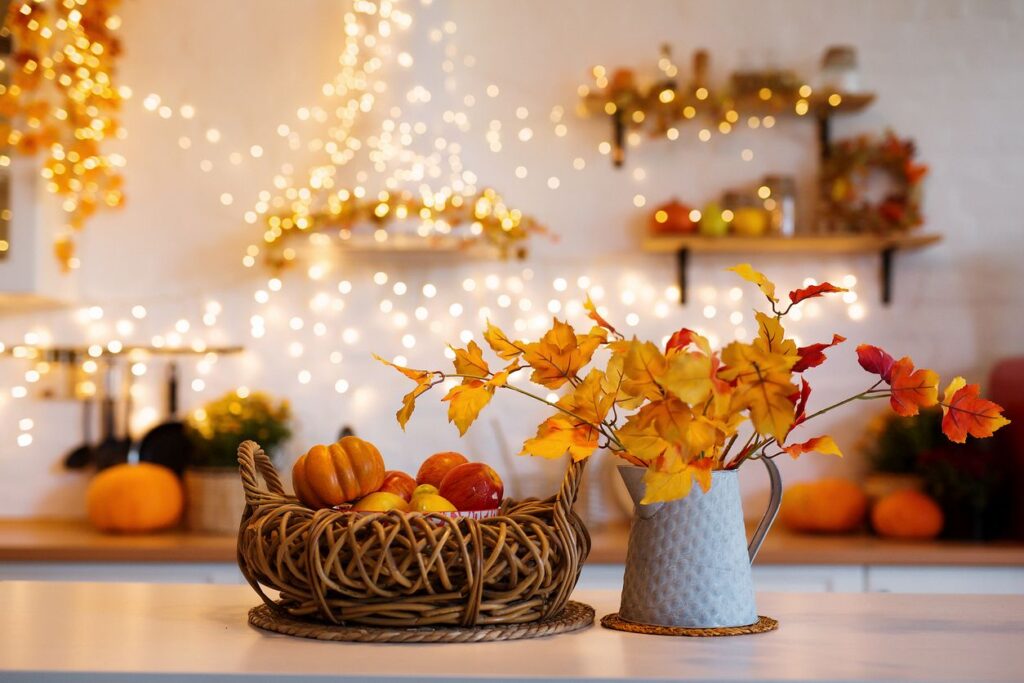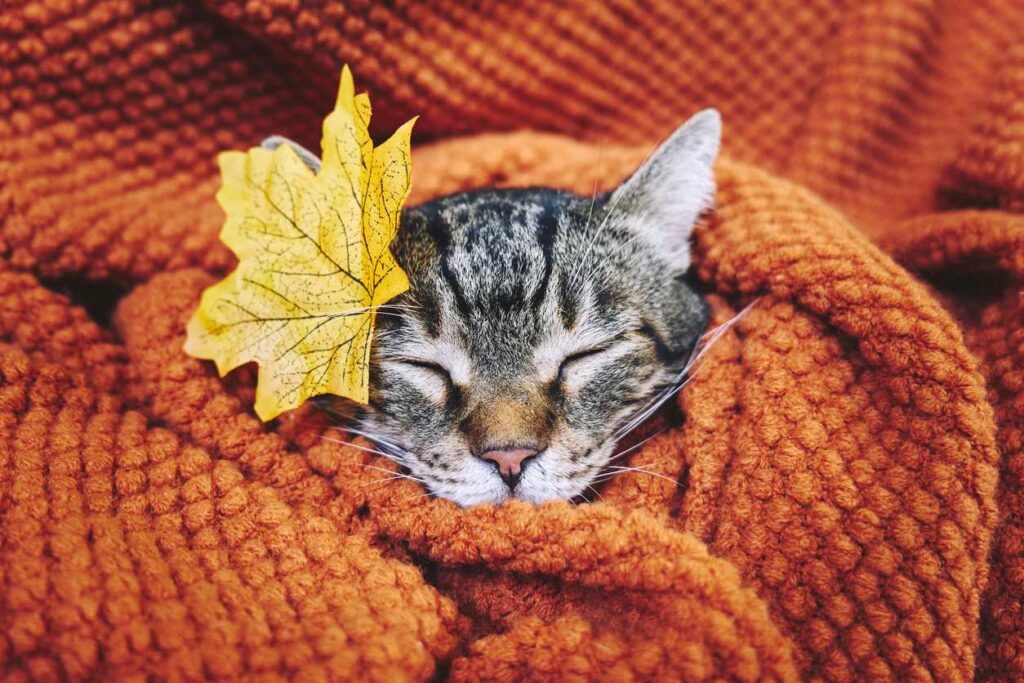Guide for Taking Care of Indoor Plants
From moving into your first apartment to relocating to a larger space, houseplants add vibrancy and life to your living area. However, caring for houseplants can be challenging, especially for beginners, as different plants have varying needs, and it can feel overwhelming to figure out all the necessary conditions. If you’re unfamiliar with caring for...
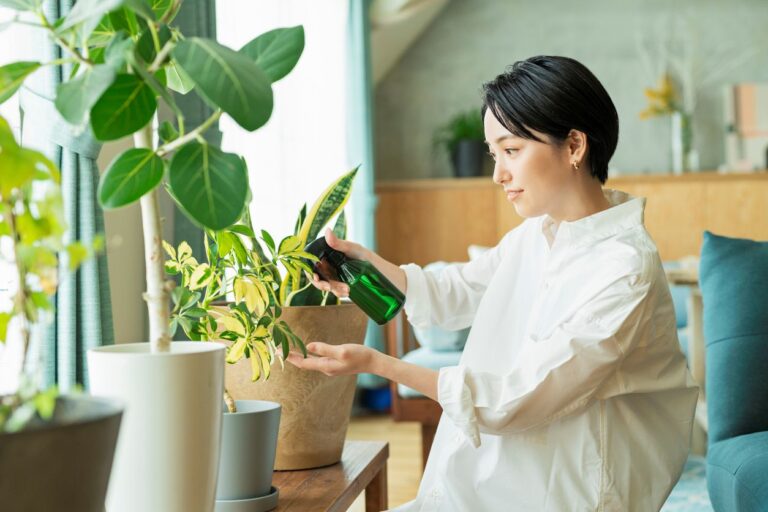
- 8 Minute Read
From moving into your first apartment to relocating to a larger space, houseplants add vibrancy and life to your living area. However, caring for houseplants can be challenging, especially for beginners, as different plants have varying needs, and it can feel overwhelming to figure out all the necessary conditions.
If you’re unfamiliar with caring for indoor plants or looking to expand your collection, don’t worry about accidentally killing your plants with overwatering or not enough light—keep reading our blog for practical tips on caring for your houseplants and keeping them thriving at home!
Best Indoor Plants
There is a wide variety of indoor plants to choose from, including cacti and leafy trees. Some do much better in certain locations than others, so explore our houseplant recommendations below:
*Indicates that these plants are toxic to cats and dogs. Keeping them out of reach and away from your pets is advisable.
A Lucky Chinese Money Tree
The Chinese money tree, Pachira aquatica, is believed to symbolize prosperity and attract good luck, so having one of these in your home can only bring benefits! These low-maintenance tropical wetland trees can grow up to eight feet tall in suitable indoor conditions, while in the wild, they can reach heights of up to 60 feet.
These plants prefer bright, indirect light and thrive in temperatures ranging from 60° F to 75° F to prevent rapid soil drying and leaf burning. After planting your money tree in soil formulated for money trees or a well-draining potting mix containing sand, pebbles, or perlite, you can water your plant every one to two weeks when the soil is 50% dry.
A Towering Snake Plant*
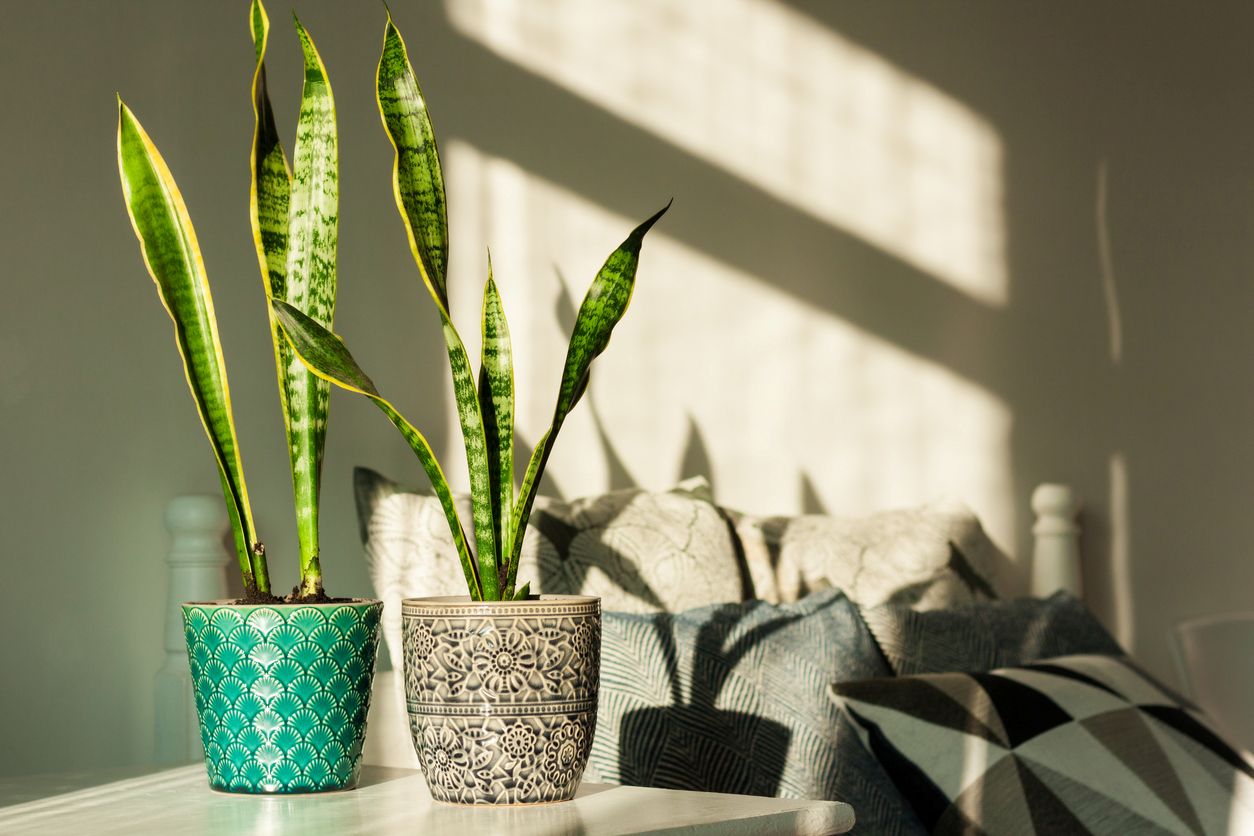
Native to West Africa, snake plants, or Dracaena trifasciata, are an excellent choice for beginner plant parents. These plants are nearly impossible to kill, only requiring water once a month, allowing the soil to dry out before each watering.
Snake plants prefer bright to medium indirect, filtered sunlight and prefer indoor temperatures between 70° F and 90° F, meaning you can even place them outside on a porch or patio during the summer in the right climate! These plants can grow anywhere from eight inches to 12 feet tall, depending on the variety.
[H3] A Splendid Spider Plant
Spider plants, also known as Chlorophytum comosum, are another fantastic option for indoor plant beginners! These fast-growing plants thrive in bright to moderate indirect sunlight and require watering once a week.
They spread quickly by sending out shoots with various “babies” that begin to sprout. In warmer climates, spider plants can be grown as ground cover due to their rapid spreading. You can even place spider plants in a hanging basket or use them as a grassy feature for flower pots during the summer!
A Smooth Rubber Plant*
Native to Southeast Asia, Indonesia, and southern China, the rubber plant, or Ficus elastica, is an easy-to-care-for, adaptable plant that can bounce back quickly if there’s a bump in its care routine. These plants can grow up to six to ten feet tall in the right conditions—in bright, indirect sunlight and with weekly watering. Next spring, you can repot your rubber plant when it reaches about two to three times the height of its pot!
A Trailing String of Pearls*

For a more unusual yet satisfying plant to grow, try your hand at a string of pearls—also called Senecio rowleyanus. This type of trailing succulent is native to Namibia in southwestern Africa and parts of South Africa, where it can be found in natural desert habitats. These plants flourish in arid, rocky areas, often growing in the shade of other vegetation and rocks, and they also function as ground cover.
This is essential to know before buying one of these plants—one of the most common issues with string of pearls plants is overwatering, which can lead to root rot. Be sure to use a shallow, wide pot with multiple drainage holes and well-draining soil. Water every two to three weeks by lightly moistening the surface soil, and place it in a location that receives a few hours of direct sunlight in the morning and bright, indirect sunlight for the rest of the day.
An Elegant Orchid
Orchids, a.k.a. Orchidaceae, are quite low-maintenance in terms of flowering houseplants. They can be temperamental, however, when overwatered and when the temperature and humidity are too high or too low. Orchids enjoy bright, indirect sunlight, between 40% and 70% humidity, and 65° F and 75° F. Placing a small humidifier in the room with your orchid and other plants that thrive in humid conditions can make all the difference!
A well-draining planter pot with an airy, orchid-specific soil mix can help your orchid thrive. Water once a week, but avoid letting them sit in standing water, and repot every one to two years for optimal development!
Unique Air Plants
Air plants occupy minimal space but can introduce vibrant color throughout your home. These plants, known as Tillandsia, originate from tropical and subtropical regions in North and South America. They’re found clinging to tree trunks, branches, rocks, foliage, and even buildings, growing on their surfaces without extracting nutrients from the host, unlike a parasite.
There’s no need for soil or a planter with this plant! Whether you hang a small terrarium from the ceiling or have a designated spot for your air plant in the window, keep it in bright, indirect sunlight with plenty of air circulation. Another quirk about air plants—water them every 10 to 14 days by dunking them upside down in a clean container filled with lukewarm rainwater, well water, pond water, or creek water, all rich in nutrients and minerals.
Don’t have access to these types of water? Bottled spring water also works well. Avoid, at all costs, using tap water, as the chlorine within it can harm your air plants.
Beginner Tips on How To Care for Indoor Plants
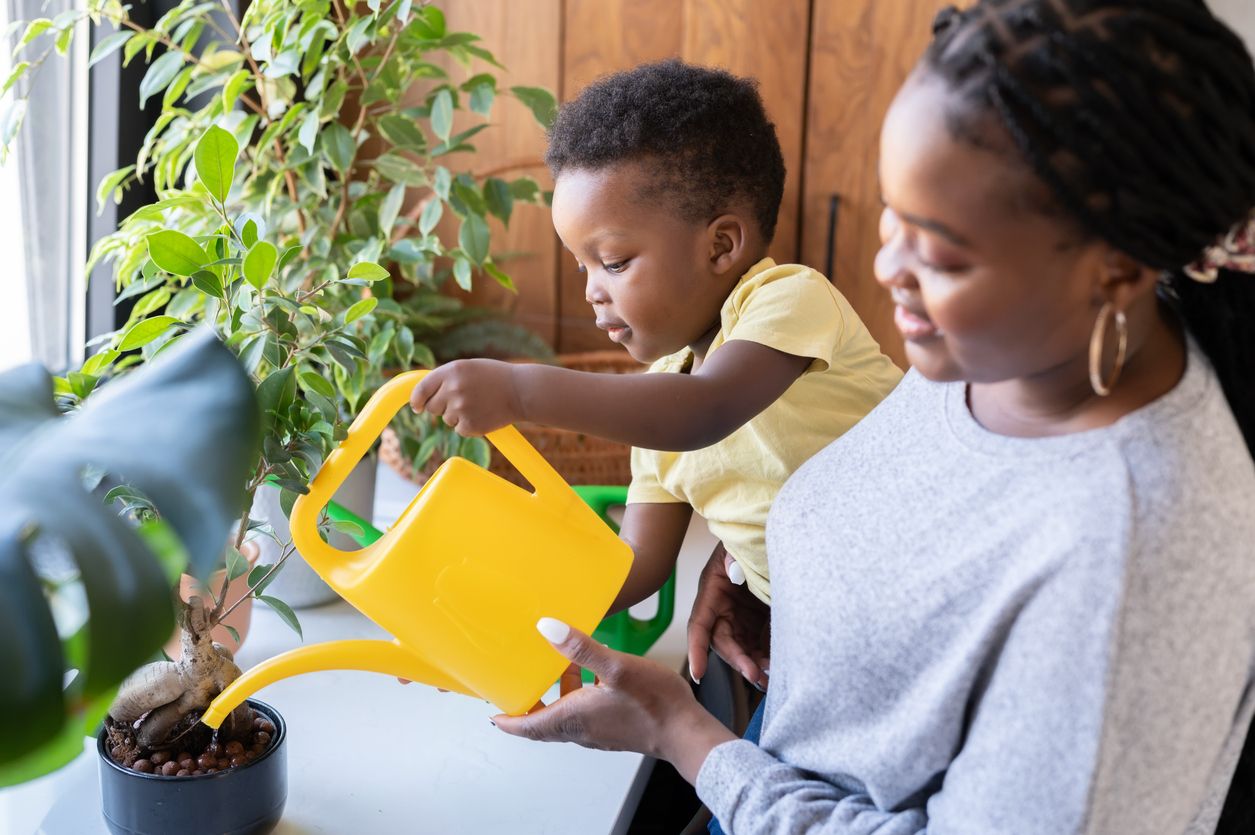
Not all indoor plants share the same characteristics and care requirements as other houseplants, including watering schedules, sunlight needs, maintenance, and propagation. Below, we’ll provide essential tips for caring for your indoor plants.
Indoor Plant Watering Guide—Overwatering vs. Underwatering
For a healthy, thriving plant, understanding its watering needs is crucial before your plant rots or dries out. These are common signs of overwatering and underwatering, and how to save them:
- Overwatering signs. Yellowing, wilting, and dropping leaves, smelly and damp soil, and the presence of fungus gnats can indicate mold or fungal growth.
- Treating overwatered plants. Drain excess water from the plant and place it in a location with good airflow and ventilation, away from cold drafts and direct heat sources. Don’t water again until the topsoil feels dry to the touch. If you notice root rot or fungus growth, remove the plant, cut away the infected parts, and repot it in a planter with proper drainage and soil mix.
- Underwatering signs. Drooping or wilting leaves that feel dry and brittle, dry curled or brown edges on the leaves, compacted dry soil in the planter, and slow or stunted growth.
- Treating underwatered plants. Move the plant to the sink and thoroughly water it, allowing it to drain from the drainage holes for 15 minutes to half an hour to soak the plant’s roots. You can also soak your plant in a full saucer of water for 30 minutes to an hour. After the appropriate time, check the soil’s moisture and repeat if necessary.
A great benefit of living in the modern age is that there’s an app for everything. Try out a plant care app, like Greg, to track your houseplants. It can help you set up a watering and fertilizing schedule, keeping you organized and on top of plant care!
Houseplant Sunlight Requirements
Every houseplant requires a different level of light to satisfy its specific care needs. From bright light to partial, filtered, or indirect light and down to low light, the type of lighting can significantly impact the growth of your plants. Here are three questions you should ask yourself before placing your houseplants in your home:
- How far is the spot from the window?
- Which direction is the window facing?
- What is in front of the window?
If another apartment building blocks your view, it can be assumed that you won’t receive much direct sunlight, so this could be a good space for low-light plants or houseplants that like artificial lighting. Do you have a lovely window seat with morning sunshine? This would be an ideal spot for succulents, cacti, and other plants that like bright, indirect light.
Five Easy Indoor Plant Maintenance Tips
In addition to consistent watering and regular fertilizing during the growing season, you can perform other small plant maintenance tasks to keep them healthy and happy:
- Adjust the humidity throughout the year.
- Make sure your plant receives plenty of light throughout the year.
- Address any pest or disease issues promptly, using neem oil or insecticidal soap as needed.
- Dust the leaves with a microfiber cloth and a leaf shine solution, and prune when necessary, to support your plant’s growth.
- Repot when required, typically in the spring.
Enjoy Your Indoor Plants at Home
Are you ready to grow a glorious jungle of tropical plants and vibrant foliage? Case & Associates has apartment communities throughout the South and Midwest, which are ideal for nurturing your plants and making an apartment feel like home!
Find an apartment community near you today or explore our blog for more tips and tricks about apartment living.


![Apartment Balcony and Patio Christmas Decorating Ideas Alt Text: A balcony with classical columns decorated with gold and red Christmas ornaments attached to pine branches. (Source) Winter is here, so it’s time to bring out the holiday cheer! Decorating an apartment balcony for Christmas is a wonderful way to get started. We know it can be tricky to find the right way to spice up your apartment for the season, but your balcony can be an excellent place to show off your decorating skills. There are plenty of creative ways to make your outdoor space festive and inviting, and today, we’ll go over small apartment Christmas decor ideas that brighten your home and make your space feel cozy, cheerful, and full of holiday spirit. [H2] Apartment Balcony Christmas Decorating Ideas With Lighting Lighting can be a great way to keep your apartment festive during the holidays or any day of the year. It’s practical, affordable, and easily adjustable, but make sure you get the perfect lights for your home. While all LEDs will save you money in efficiency, not all are made the same. If your balcony or patio is exposed to the elements, either because it’s uncovered or you experience frequent severe weather, opt for lights designed to handle outdoor conditions. Rope lights are often built into surgical tubing, and while they may not be as easy to bend around corners, they’re highly resistant to bumps, scratches, and moisture. Another great option is LED lamps. Like any lamp, they’re enclosed to keep bad weather out and can create a warm, cozy glow. For a classic holiday look, try flame-imitating bulbs, and to get the most out of your decorative lighting, plug your setup into an outlet timer so you can set exactly when your lights turn on or off. [H2] Year-Round Christmas Decor for Your Apartment Balcony Alt Text: A wreath made of dried plants and goldenrain tree seeds, wrapped in evergreen and wheat, sits on a deck railing. (Source) Some of the best Christmas decor for apartment balconies are the kind you can keep up all year. While certain decorations like inflatable Santas and stockings may need to come down after the New Year, there are plenty of festive touches that can stay outdoors long after the holidays. Wreaths are a great example, and it’s easy to refresh them with each season. You can swap out ribbons or add new ornaments for a quick, inexpensive update. Plants are another excellent way to stay festive year-round. As we mentioned in our Apartment-Friendly Christmas Decorating Ideas guide , potted Christmas trees can look great both indoors and on your balcony. With proper care, your tree can last through the year and be ready to decorate again when the holidays return. [H2] Life-Size Apartment Balcony Christmas Decorations Wreaths and garlands are one thing—but have you ever created your own Santa scene? Many families have enjoyed creating these friendly Santa mock-ups for generations. Whether it’s posed on a bench or waving from the window, they’re easy to make and fun for the whole family. Grab some old pillows and stuff them into an oversized red jacket. A foam head topped with a stocking cap and a white beard can complete the look, though feel free to get creative if you have different supplies on hand. Depending on how you style it, your Santa can look elegant, whimsical, or delightfully funny. Either way, the photos and memories will bring a smile to every guest who stops by. [H2] Keep Your Balcony or Patio Decorations Accessible We love seeing all the creative decorations our residents across our communities put up during the holidays, but it’s always important to make sure your outdoor spaces are ready to withstand winter weather without becoming a hazard. Snow, freezing rain, or even high humidity can cause your patio to ice over. Even a thin layer of ice can become slippery, especially on concrete, where it’s difficult to see. Before freezing temperatures hit, take an extra step to keep your space comfortable and accessible. Sprinkle anti-icing salt or use other approved de-icing products on your balcony or patio before setting up your decorations. This strategy works well for walkways, steps, pavers, and any ice-prone surfaces around your home. A quick pre-treatment helps keep the area ready for family gatherings, guests, and cozy evenings spent admiring your handiwork. [H2] Get Comfortable in Your New Home From Case & Associates Alt Text: A comfortable patio with wicker furniture, a string of light bulbs, and cups of hot chocolate with marshmallows on top. (Source) Find your next home in an apartment from Case & Associates. Our communities across the Midwest and South are built with convenience and comfort in mind, with upscale amenities designed to make every season enjoyable. From personal fireplaces and private patios to beautiful poolside views, there’s always a cozy spot to celebrate the holidays with loved ones. Browse our available apartments at a Case & Associates community near you, and see how easy it can be to call one of our communities home. We’d love to show you around and help you find the perfect place to start your next chapter. Contact Case & Associates today to schedule a tour.](https://cdn.caseusa.com/wp-content/uploads/2025/11/iStock-1262767169-1024x683.jpg)
